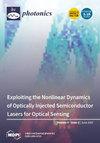Long-Term Stability Test for Femtosecond Laser-Irradiated SnO2-Nanowire Gas Sensor for C7H8 Gas Sensing
IF 2.1
4区 物理与天体物理
Q2 OPTICS
引用次数: 0
Abstract
In this study, femtosecond (FS) laser irradiation with different laser energy densities of 138, 276, and 414 mJ/cm2 is applied to SnO2-nanowire (NW) gas sensors, and the effect of the FS laser irradiation on the gas sensor response toward toluene (C7H8) gas is investigated. The FS laser irradiation causes oxygen deficiency in the SnO2 NWs and forms SnO and SnOx. Moreover, an embossing surface with multiple nano-sized bumps is created on the SnO2 NW surface because of the FS laser irradiation. The FS laser-irradiated SnO2-NW gas sensor exhibits superior sensing performance compared with the pristine SnO2-NW gas sensor. Moreover, the FS laser energy density significantly affects gas-sensing performance, and the highest sensor response is achieved by the gas sensor irradiated at 138 mJ/cm2. The long-term stability test of the laser-irradiated SnO2-NW gas sensor is performed by comparing fresh and 6-month-old gas sensors in different gas concentrations and relative humidity levels. Comparable gas-sensing behaviors are examined between the fresh and 6-month-old gas sensor, and this verifies the robustness of the laser-irradiated SnO2-NW gas sensor.用于 C7H8 气体传感的飞秒激光辐照 SnO2 纳米线气体传感器的长期稳定性测试
本研究采用 138、276 和 414 mJ/cm2 不同能量密度的飞秒 (FS) 激光辐照 SnO2 纳米线 (NW) 气体传感器,并研究了 FS 激光辐照对气体传感器对甲苯 (C7H8) 气体响应的影响。FS 激光辐照会导致二氧化锡纳米线缺氧,并形成氧化锡和氧化锡。此外,FS 激光辐照还在 SnO2 NW 表面形成了具有多个纳米级凸起的压花表面。与原始 SnO2-NW 气体传感器相比,经过 FS 激光辐照的 SnO2-NW 气体传感器具有更优异的传感性能。此外,FS 激光能量密度对气体传感性能有显著影响,138 mJ/cm2 激光辐照下的气体传感器响应最高。通过比较在不同气体浓度和相对湿度水平下的新传感器和使用 6 个月的传感器,对激光辐照过的 SnO2-NW 气体传感器进行了长期稳定性测试。结果表明,新鲜传感器和使用 6 个月的传感器具有相似的气体感应性能,这验证了激光辐照 SnO2-NW 气体传感器的稳定性。
本文章由计算机程序翻译,如有差异,请以英文原文为准。
求助全文
约1分钟内获得全文
求助全文
来源期刊

Photonics
Physics and Astronomy-Instrumentation
CiteScore
2.60
自引率
20.80%
发文量
817
审稿时长
8 weeks
期刊介绍:
Photonics (ISSN 2304-6732) aims at a fast turn around time for peer-reviewing manuscripts and producing accepted articles. The online-only and open access nature of the journal will allow for a speedy and wide circulation of your research as well as review articles. We aim at establishing Photonics as a leading venue for publishing high impact fundamental research but also applications of optics and photonics. The journal particularly welcomes both theoretical (simulation) and experimental research. Our aim is to encourage scientists to publish their experimental and theoretical results in as much detail as possible. There is no restriction on the length of the papers. The full experimental details must be provided so that the results can be reproduced. Electronic files and software regarding the full details of the calculation and experimental procedure, if unable to be published in a normal way, can be deposited as supplementary material.
 求助内容:
求助内容: 应助结果提醒方式:
应助结果提醒方式:


